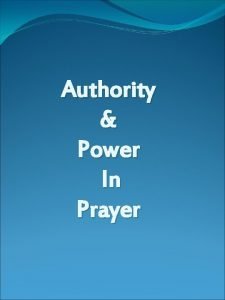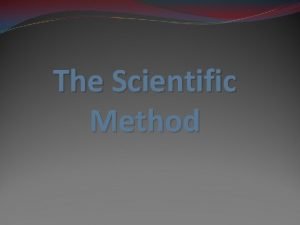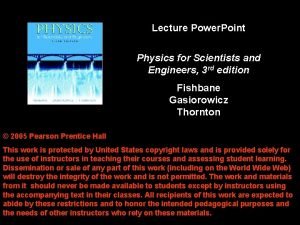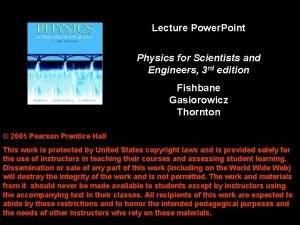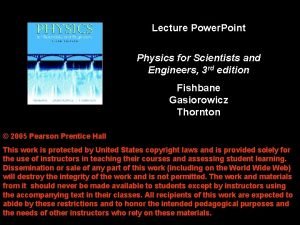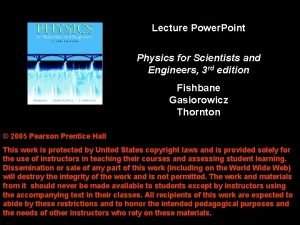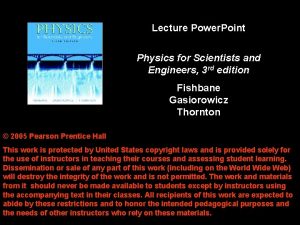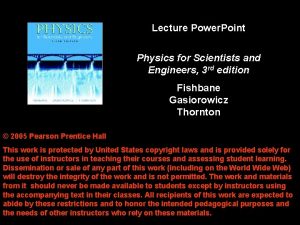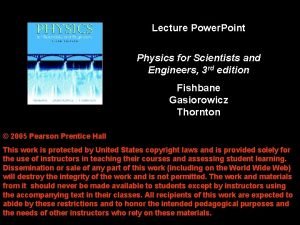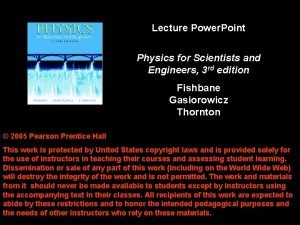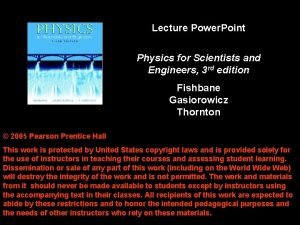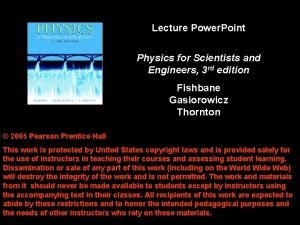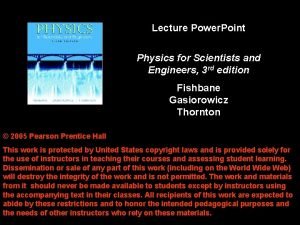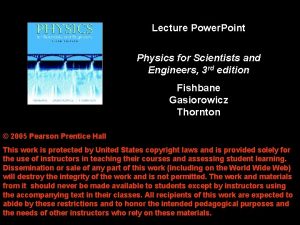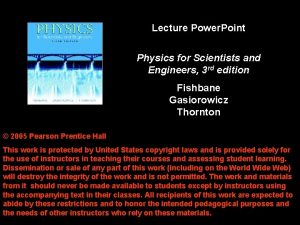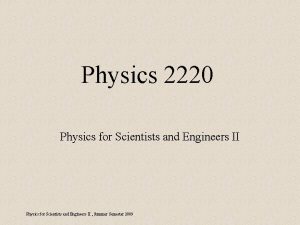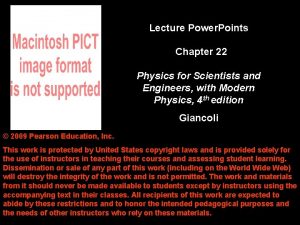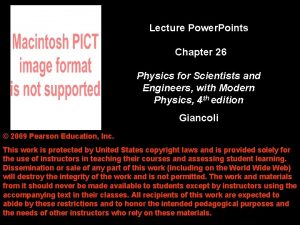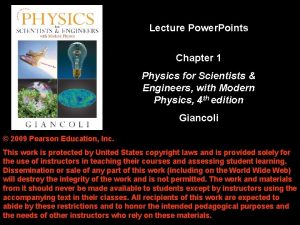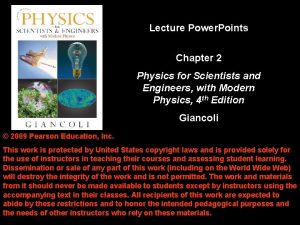Lecture Power Points Physics for Scientists and Engineers



















- Slides: 19

Lecture Power. Points Physics for Scientists and Engineers, 3 rd edition Fishbane Gasiorowicz Thornton © 2005 Pearson Prentice Hall This work is protected by United States copyright laws and is provided solely for the use of instructors in teaching their courses and assessing student learning. Dissemination or sale of any part of this work (including on the World Wide Web) will destroy the integrity of the work and is not permitted. The work and materials from it should never be made available to students except by instructors using the accompanying text in their classes. All recipients of this work are expected to abide by these restrictions and to honor the intended pedagogical purposes and the needs of other instructors who rely on these materials.

Chapter 27 Direct-Current Circuits

Main Points of Chapter 27 • emf and its meaning • Internal resistance • Kirchhoff’s loop and junction rules • Multi-loop circuits • Measuring instruments • RC circuits

27 -1 EMF • An emf is a source of energy in a circuit that causes charges to move • Circuit with battery and resistor: potential difference between battery terminals causes current to flow through resistor • Chemical reactions inside battery send charge back to terminal • Definition of emf: (27 -1)

27 -1 EMF Internal resistance • Battery with emf of 9 V will not necessarily have 9 V potential difference between its terminals, due to internal resistance: (27 -5) where r is the internal resistance.

27 -2 Kirchhoff’s Loop Rule • Single-loop circuit has just one path for current • Beginning at any point in circuit and going all the way around must involve a total potential change of zero (you come back to where you started) • When moving in the direction of the current, potentials decrease across resistors and increase across batteries • Sum of potential changes around a closed path is zero: (27 -9)

27 -2 Kirchhoff’s Loop Rule Basic single-loop circuit:

27 -2 Kirchhoff’s Loop Rule • When moving around the loop opposite to the direction of the current, potential difference increases across resistors and decreases across batteries • Across a capacitor from – side to + side, potential increases; in other direction it decreases

27 -3 Kirchhoff’s Junction Rule • All the current that comes into a junction must go out again • The algebraic sum of the currents entering a junction equals zero (27 -11)

27 -3 Kirchhoff’s Junction Rule • Solving multi-loop circuits: • Use both junction and loop equations • Some will be redundant • Need as many independent equations as there are unknown currents • A circuit with n junctions will have n – 1 independent junction equations

27 -3 Kirchhoff’s Junction Rule Example: • This circuit requires three independent equations • This circuit has two junctions; two of the equations will have to be loop equations

27 -4 Measuring Instruments • Ammeter measures current • Voltmeter measures potential difference • Ohmmeter measures resistance • Multimeter does all three

27 -4 Measuring Instruments • Ammeter: connect in series; very small resistance compared to other circuit elements, so current is not affected • Voltmeter: connect in parallel; large resistance, so voltage is not affected • Internal resistance of voltmeter can be varied to allow different voltage scales

27 -5 RC Circuits RC circuit with battery and switch • Switch at position A: battery charges capacitor • Switch at position B: capacitor discharges through resistor

27 -5 RC Circuits Current stops flowing when capacitor is fully charged: Charge as a function of time: (27 -22) Current as a function of time: Time constant: (27 -23)

27 -5 RC Circuits Current and charge as functions of time

27 -5 RC Circuits Discharging: charge decreases with same time constant

Summary of Chapter 27 • Sources of emf are sources of electric energy • emf is defined by work it can do: (27 -1) • Kirchhoff’s loop rule: (27 -9) • Kirchhoff’s junction rule: (27 -11)

Summary of Chapter 27, cont. • Capacitor being charged by battery has charge and current: (27 -22) (27 -23) • When discharging, (27 -26)
 01:640:244 lecture notes - lecture 15: plat, idah, farad
01:640:244 lecture notes - lecture 15: plat, idah, farad Brand frame of reference
Brand frame of reference Points of parity and points of difference
Points of parity and points of difference Real power and reactive power
Real power and reactive power Power system dynamics and stability lecture notes
Power system dynamics and stability lecture notes Power system dynamics and stability lecture notes
Power system dynamics and stability lecture notes Classical mechanics
Classical mechanics Physics 101 lecture
Physics 101 lecture Physics 101 lecture 1
Physics 101 lecture 1 Physics 101 lecture notes pdf
Physics 101 lecture notes pdf Waves pdf notes
Waves pdf notes Atmospheric physics lecture notes
Atmospheric physics lecture notes Prayer of authority
Prayer of authority Power system analysis lecture notes
Power system analysis lecture notes Power semiconductor devices lecture notes
Power semiconductor devices lecture notes Switch mode power supply lecture notes
Switch mode power supply lecture notes After the experiment scientists organize and the data
After the experiment scientists organize and the data Diagrams tables and graphs are used by scientists mainly to
Diagrams tables and graphs are used by scientists mainly to Why does it happen
Why does it happen University physics with modern physics fifteenth edition
University physics with modern physics fifteenth edition












